>

Yemen is a country which has been taken from a fairy tale, a destination that keeps awing each and every visitor who gets captivated by the mesmerising architecture that dot the unexpectedly radiant and fertile valleys that compose the country.
Local men strolling the streets with their colorful jabiya – traditional dagger – are the cheery on top that make Yemen such a unique country, because there’s nothing like Yemen, and not only in terms of sights but years of isolation have made Yemen an incredibly raw country where travelers can still experience Yemeni rural life as it used to be centuries ago.
Traditionally grouped in tribes with strong codes of conduct that tend to prevail over the country’s law, their rules dictate that one must protect their guest, with their own life if needed, and treat them like one more member of their family.
The result is a particularly warm and welcoming society whose main aim is always veiling for your safety and feed you with the best honey and Yemeni food.
Yemen is certainly one of the most legendary countries in the world.
In this travel guide to Yemen you will find the latest, updated info on how to travel to Yemen, including safety, how to get a visa and more.
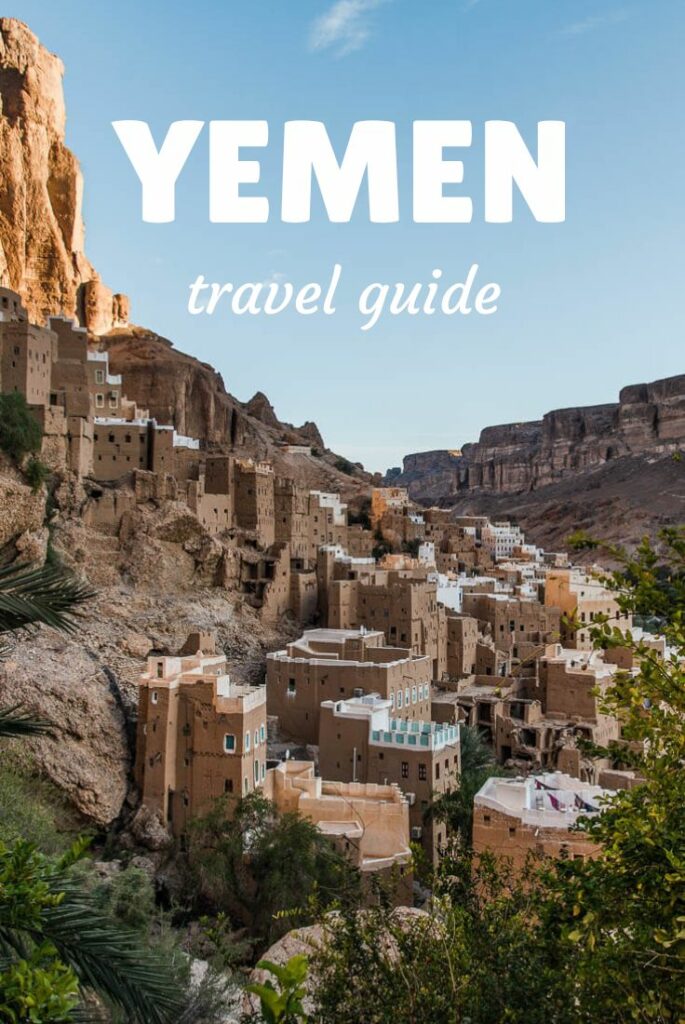
In this Yemen travel guide, you will find:
COVID-19 RestrictionsWhich region of Yemen mainland can you visit?Top experiencesIs it safe to travel?How to get a visaBest time to visitUseful books for travelingIndependent travelHow to get to YemenThe country, people and cultureYemeni food and cuisineSolo female travelerMoney and pricesTransportationWhere to stayInternetMore Information
COVID-19 restrictions for traveling to Yemen
As of today, there are no COVID-19 restrictions for visiting Yemen.Yemen is a complicated country which is going through an even more complicated conflict, and it’s important to understand where are you getting into.
Travel Insurance for Yemen with COVID-19 coverage
IATI Insurance is one of the few providers that offers full Coronavirus coverage, not only when it comes to treatment, but also cancellations costs in case you tested positive before departure. And not only this, but it’s one of the few insurance providers that gives coverage for traveling to Yemen.Readers of Against the Compass can get an exclusive 5% discount.CLICK HERE TO GET 5% EXCLUSIVE DISCOUNT
There are 2 Yemens, north and south
Before visiting Yemen, you should know that the country is divided into two separate, big regions:
Yemen Arab Republic, also known as North Yemen
People’s Democratic Republic of Yemen, also known as South Yemen
By the way, the capital Sanaa is in North Yemen.
In the 19th century, North Yemen was under Ottoman rule, while Britain was controlling South.
When the Ottoman Empire collapsed in 1918, North Yemen became an independent state, but the British kept ruling over South Yemen until 1967.
After the British withdrawal in 1967, North and South Yemen were two separate UN countries until they unified in 1991, becoming the Yemen Arab Republic.
North Yemen is where most issues are happening
As a traveler, you need to be aware that, despite the unification, this division is still part of every day Yemen, both politically and culturally.

Typically, Yemenis wearing a jabiya are from the North
First of all, all the bad things you hear about Yemen, like famine and aerial bombings – the world’s worst humanitarian crisis according to some sources – are mostly happening in North Yemen, a region today controlled by the Houthies, a militia that belongs to a branch of Shia Islam who wants to take control of the country.
Saudi Arabia is trying to get rid of them.
South Yemen is mostly pro-Saudi, but it’s pretty messy too.
South Yemen on the other hand, is controlled by the Yemeni Government, which is extremely pro-Saudi.
However, the members of the Government are not living there anymore, but they are all exiled in Saudi Arabia, leaving the country mostly under the control of the Yemeni Army. It’s quite a mess.
To make things even more complicated, part of South Yemen is controlled by the STC (Southern Transitional Council), a separatist group who wishes South Yemen to become an independent country.
They are supported by the United Arab Emirates, who fight against Saudi over power, believe it or not.
As a foreign traveler, North Yemen is today off limits. More on that in the following section.
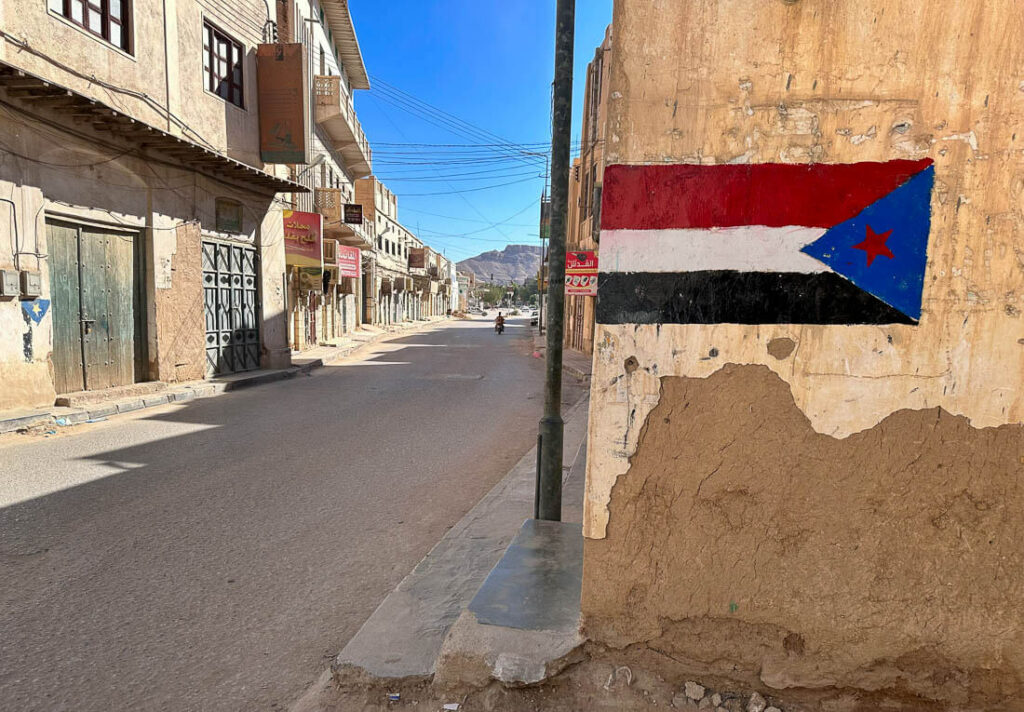
A separatist flag from South Yemen
Which region of Yemen mainland can you visit?
Can you visit North Yemen?
Today, North Yemen – and that includes the capital Sanaa – is practically impossible to visit.
The area is not under the jurisdiction of the Yemeni Government, hence getting the necessary security clearances and permits for going through all the checkpoints is difficult.
Difficult, not impossible, but even with all the necessary permits, there is a high chance of getting arrested, like it happened to a friend of mine who spent one week traveling in North Yemen, until the Houthies decided to lock him up for a week, giving him a very hard time.
You might bump into a fixer who sells you the yummy, irresistible idea of traveling all the way to Sanaa but in my opinion, this is still a bit sketchy, and my recommendation would be to wait until things calm down a bit more.
I’ll be updating this post as soon as I figure out more about visiting Sanaa.
Fun fact: How many tourists visit Yemen mainland each year?Less than 200 people visit Yemen (mainland) each year.
From the western city of Aden all the way to the border with Oman, South Yemen comprises around two thirds of the country, but the only place you can visit is a region named Hadramut, the only stable region in the country.
That’s where I traveled to.
Hadramut is a beautiful, mostly rural region home to jaw-dropping valleys and postcard-like mud-villages often dominated by hypnotic palaces once owned by the local sultans.
Shibam, a city entirely built of 9-story mud-made buildings in the middle of the desert, is today a UNESCO World Heritage Site and by far, the highlight of Yemen.
Hadramut by itself is certainly worth the trip to mainland Yemen.
Can you visit Socotra?
Socotra is a remote Yemeni island, which has a peculiarly unique geology and flora, as well as home to a Yemeni society with significant cultural differences due to their isolation from Yemen mainland.
For many years, Socotra has been sort of a hotspot for intrepid travelers looking for some real off the beaten path adventures. The island is used to receive visitors, so you can find some relatively developed tourism infrastructure ran by a few local tour operators.
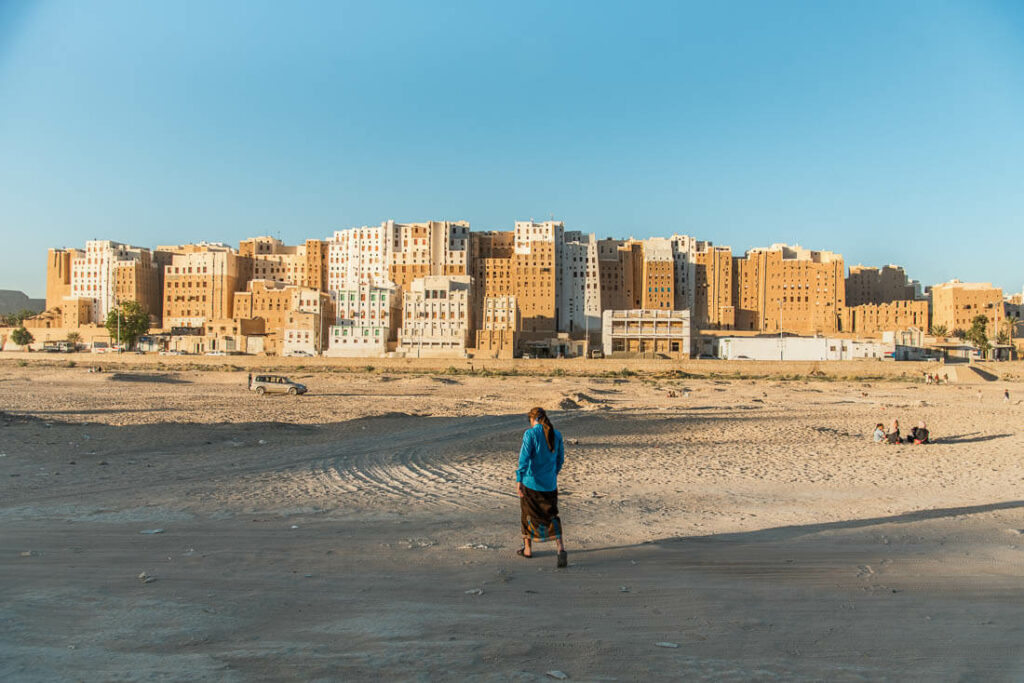
Visit Hadramut
Top experiences in Yemen
Visiting the mud-made towns like Shibam
And I specify towns because this isn’t like the tiny mud village you may find in Mali or Sudan but they are actual towns built in the past as caravan cities.
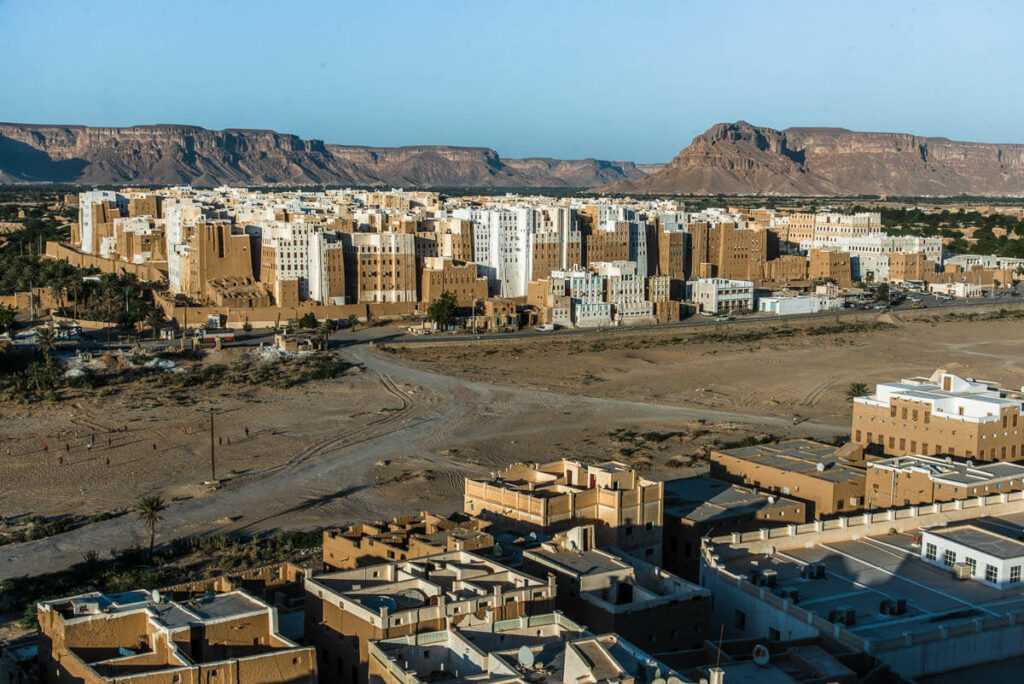
This is Shibam
Shopping in a khat market
In addition to sparing one day for chewing khat, visiting one of the many khat markets with tens of stalls selling all sorts of types and quality of khat is a real highlight.
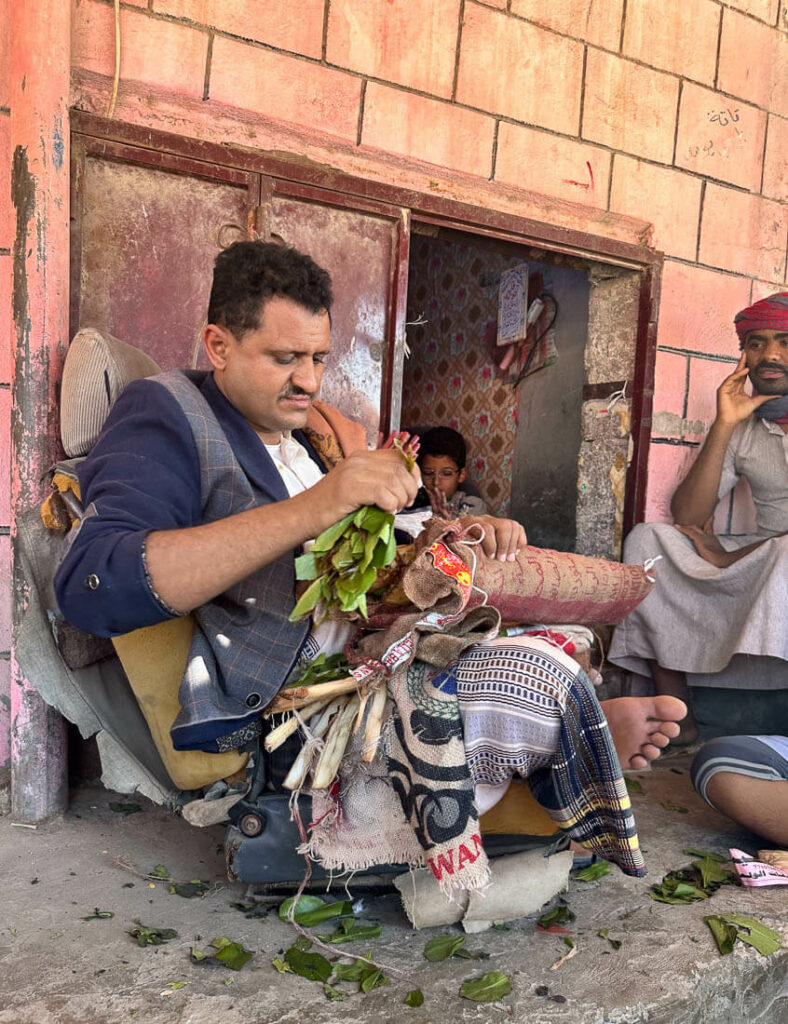
A khat seller
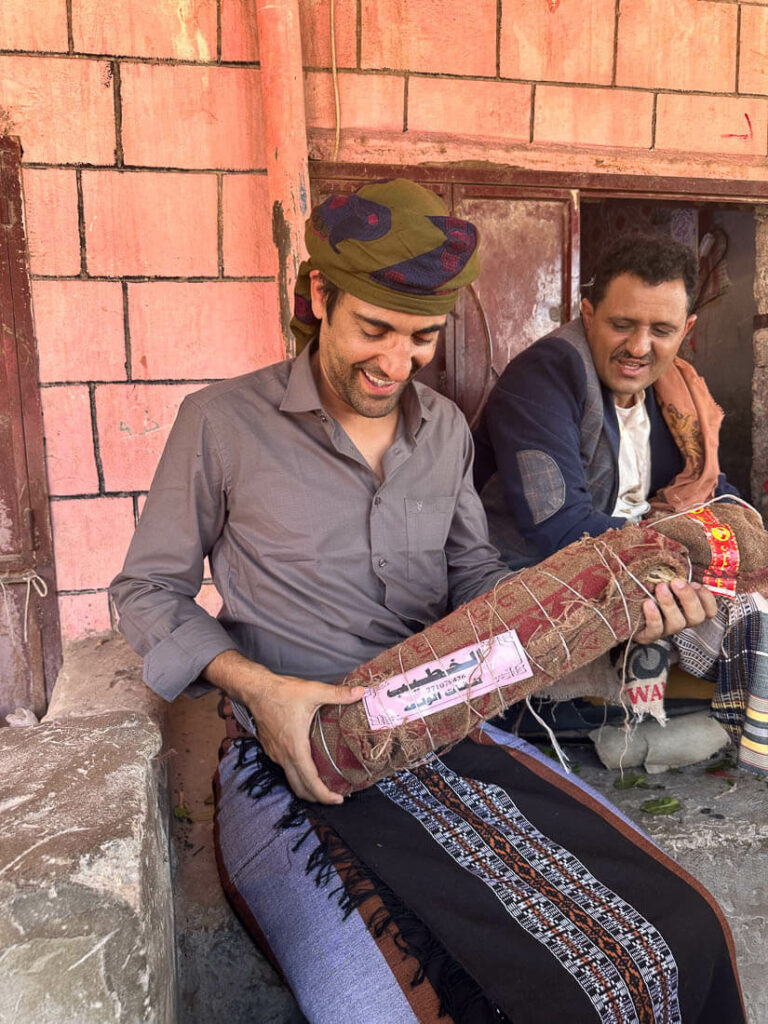
We bought this badge for around $18. It’s for 2 people
Meeting Yemeni people
With their daggers, traditional clothes, smiles and hospitality, meeting Yemenis are an essential part of any trip to Yemen.

A fruit seller in the market of Seiyun
Trekking around Wadi Doa’n
This canyon-shaped valley offers plenty of trekking opportunities through unspoiled villages and spectacular views.
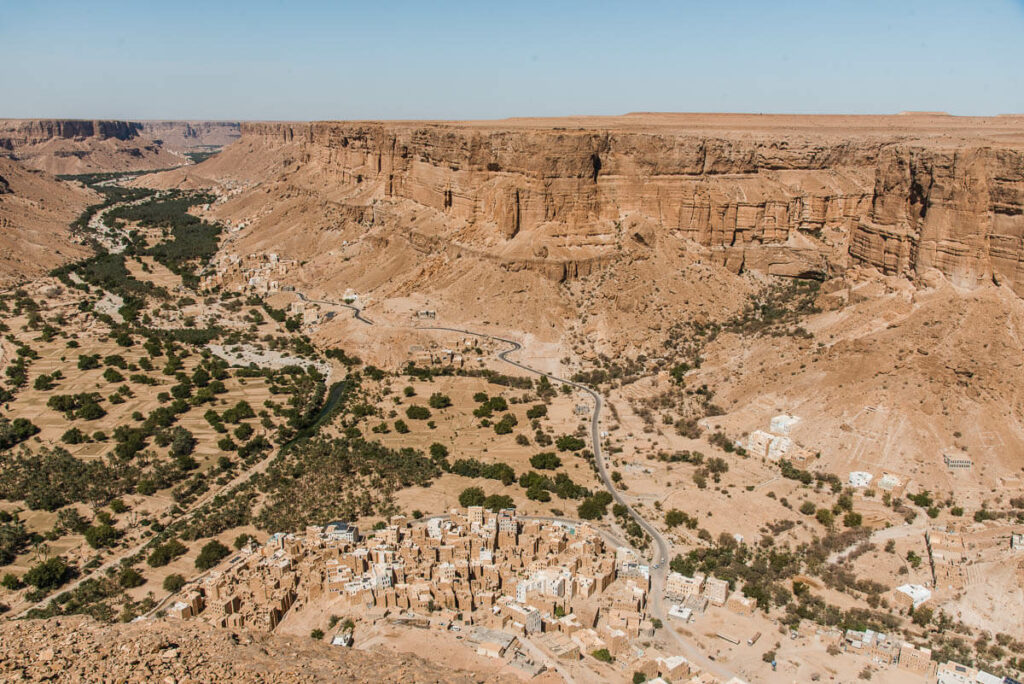
This is Wadi Doa’n
Is it safe to travel to Yemen?
The Foreign, Commonwealth & Development Office (FCDO) advises against all travel to Yemen, including both Yemen mainland and Socotra.
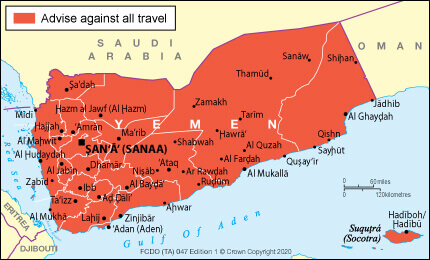
Yemen travel warning according to the FCDO
I have done safety analysis for several countries – only from a tourist perspective – and my answer to the FCDO advice is always the same: their analysis are extremely biased and based on extremely unlikely scenarios, since they want nothing to do with travelers venturing in those areas if the extremely unlikely happened.
The situation in Hadramut is arguable, yes, but Socotra is an isolated paradise that always stayed at the edge of the conflict, the reason why it keeps receiving thousands of tourists every year.
My personal perspective on safety in Yemen
You already learnt that when talking about Yemen, one must be able to differentiate between North Yemen and South Yemen, the first being the apparent dangerous part of the country.
However, I haven’t been in North Yemen, so I can’t really verify whether that region is safe or not.
Actually, nobody does, since you can’t really travel there nowadays.
Similarly, South Yemen is pretty big, but the only place which can be visited is Hadramut, so this section will mainly focus on safety in Hadramut.
Is it safe to travel to Hadramut?
This is a difficult question to answer.
When I was traveling around Hadramut, everything felt very safe indeed, and it shouldn’t be a coincidence that Hadramut is the only area in Yemen which foreigners are allowed to visit.
Hadramut Insurgency
Nonetheless, we can’t obvious the fact that from 2016 to 2018, Hadramut had a large presence of Al-Qaeda an ISIS, terrorist groups that were even controlling the regional capital: Mukalla.
For nearly two years, suicide bombings and actual fighting happened nearly every day.
The situation, however, has drastically improved, since the area has been cleared up from terrorists, hence they decided to open it for international tourists.
Still, one must travel to Hadramut with extra caution but at the end of the day, you will certainly do that because:
Independent travel is not allowed and one must always be with their local guide, who will not allow you to wander around on your ownYou must be accompanied at all times by Yemeni armed escorts during your trip in Hadramut, and you must pay for their service.There are endless checkpoints
It’s difficult to say whether Hadramut is safe or not: your trip to Yemen will be rather short, you will always be with armed escorts and an expert fixer who knows where to go and how to deal with complicated situations.
Would it be safe if you traveled to Yemen as an independent backpacker?
We don’t know because nobody has done it so.

My fixer and driver. Many Yemenis are armed with AK47
How to get a visa for Yemen
A visa is strictly required for traveling to Yemen.
Good news is that all nationalities can apply for a tourist visa, an easy, straightforward process – as long as you can afford it.
Bad news is that you can only get it through a local fixer, with whom you must book a full tour – like in Syria – and it’s usually pretty expensive.
Typically, the visa takes around 1 full month to process, but this is Yemen, and it’s recommended to get in touch with your local fixer/tour operator way before that.
Everything can be arranged on WhatsApp, and all you need to do is sending a copy of your passport, a passport photo and a filled out form.
In addition to the Yemeni visa, your local tour operator/fixer will also apply for a security clearance, something needed for going through all checkpoints.
Your fixer should send you your visa via email and all you’d have to do is printing it out and collect your stamp upon arrival in Yemen.
The visa process for Socotra is pretty similar, but it’s a distinct process that shall be done with Socotra-specific tour operators. A visa for mainland Yemen is not valid for Socotra and viceversa.
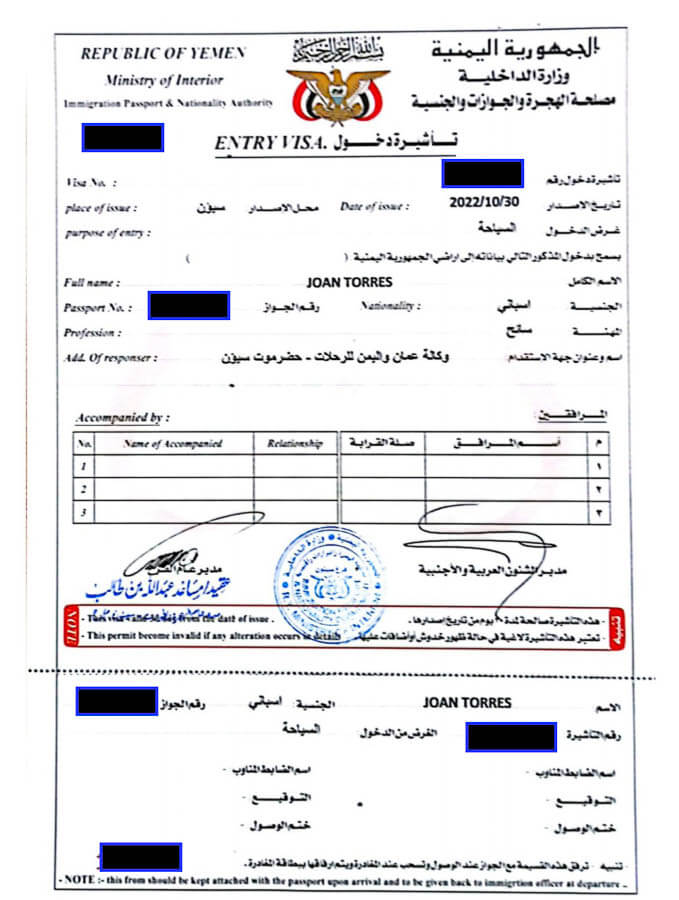
Travel insurance for Yemen
Travel insurance for Yemen is a real must, especially in times of pandemic, and I strongly recommend IATI Insurance because:One of the very few that covers travel in Yemen.They have many different plans, for all budgets.Covers both short-term trips and 1-year long trips.It covers a wide range of COVID-related stuff.It covers senior citizens tooReaders of this blog can get a 5% exclusive discountCLICK THROUGH THIS LINK TO GET 5% SPECIAL DISCOUNT
Best time to visit Yemen
Like in other Gulf countries, such as Oman or Saudi Arabia, you should avoid traveling in Yemen during the summer months.
I did visit Yemen in the month of November. Days were warm but rarely over 30ºC and evenings were pleasant.
Useful books for traveling in Yemen
Yemen travel guide by Lonely Planet
Very outdated (1999) by the only available guidebook to the country.

Check on Amazon
Tribes and Politics in Yemen: A History of the Houthi Conflict
Indispensable book to understand everything related with today’s conflict.

Check on Amazon
Independent travel in Yemen mainland
Can you travel in Yemen mainland independently?
Unfortunately not.
Today, independent travel in Yemen is strictly forbidden, including within Hadramut.
My fixer in Yemen told me the story of a Japanese traveler who tried to escape while having an after lunch break at the hotel, time which the tourist took advantage to buy or rent a motorbike.
He was detained at the first checkpoint and wasn’t allowed to leave until the fixer showed up.
Moreover, traveling in Yemen is so restricted that you can’t even change your itinerary once permits have been issued because those permits must specify the dates you will be in each area of Yemen.
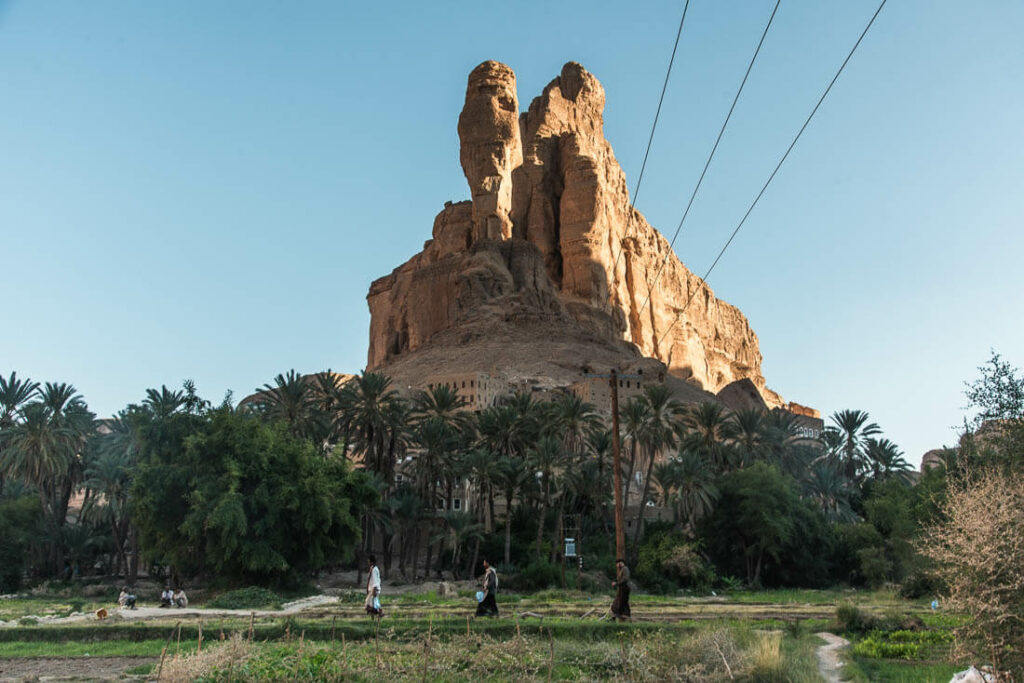
Visiting a remote village with our driver and escort somewhere in Hadramut
How to get to Yemen
How to travel to Yemen by air
Today, the only feasible way to travel to Yemen mainland by air is with Yemenia Airways via Cairo to a city named Seiyun.
There are 3 to 4 flights a week and tickets must be purchased via a tour agent based in Cairo, the contact of which should be shared by your Yemeni tour operator.
In my case, I reached out the mentioned tour agent on WhatsApp, who told me to wire her the total cost of the flight ticket to an Egyptian bank account.
The round-trip ticket from Cairo to Seiyun cost 870USD.
After a week, she acknowledged receipt of the money and sent me a copy of my flight ticket, also on WhatsApp.
It was a strange but a pretty simple and legit process.
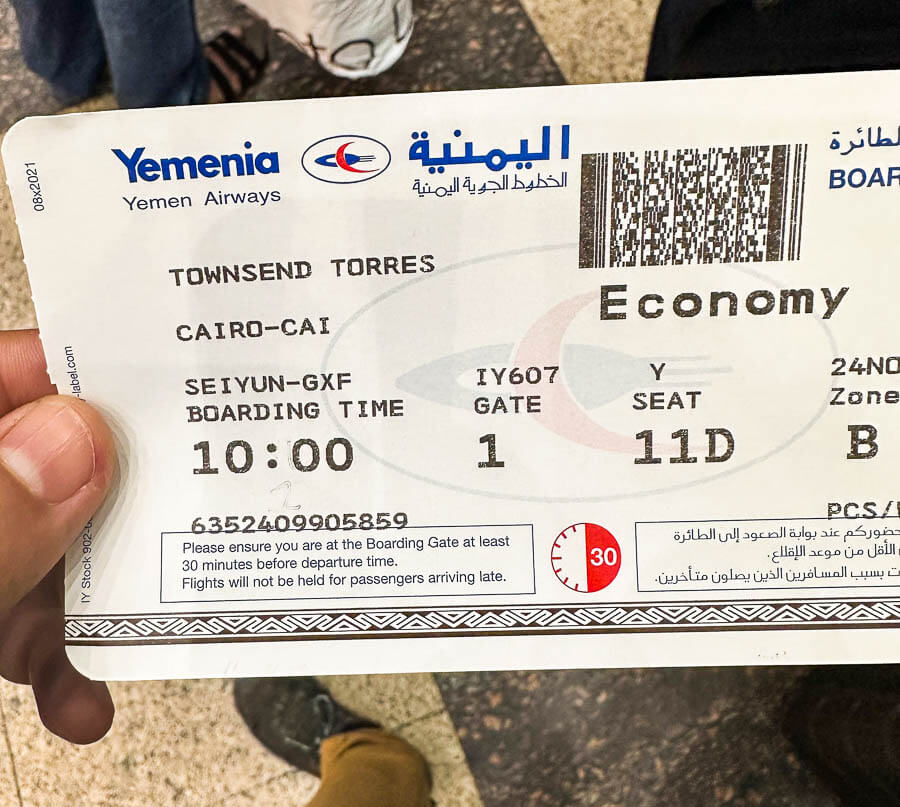
How to fly to Yemen
How to travel to Yemen by land
Yemen shares a border with Oman and Saudi Arabia.
How to travel to Yemen from Oman
The border is fully open because the region of Salalah in Oman leads directly to Hadramut.
Nevertheless, my fixer stopped picking up travelers from the Omani border because as of today, the scenic coastal road that leads to Mukallah is controlled by the STC, therefore it remains closed to foreigners.
Alternatively, you can use the northern road, but that involves driving over 600km (one-way) through an empty desert, and that’s something he doesn’t really want to do anymore, especially because he would have to come all the way from Seiyun and back, a 1200km journey.
How to travel from Saudi to Yemen
With proper clearance, you can use the Al Wadeeah border.
I know a few people who have crossed into Saudi from Yemen using that border, but I don’t know anyone who has actually entered Yemen from there.
Travel reports on that matter are welcome.
Chewing khat in Yemen
Khat is a local plant and a drug – similar to coca leaves – typically consumed in Yemen but also in the Horn of Africa, especially in Somalia, southeast Ethiopia, Djibouti and north Kenya. Yemeni men are addicted to it and basically, life stops every day after lunch time for chewing khat. It’s an actual social problem because khat isn’t cheap and there are many Yemeni men who spend their wages in this drug rather than buying food for their families. Still, if you are traveling in Yemen, you must spare one afternoon to chew khat with the locals. If you buy the best quality one, it will give you an extra dose of energy and that night you won’t sleep.
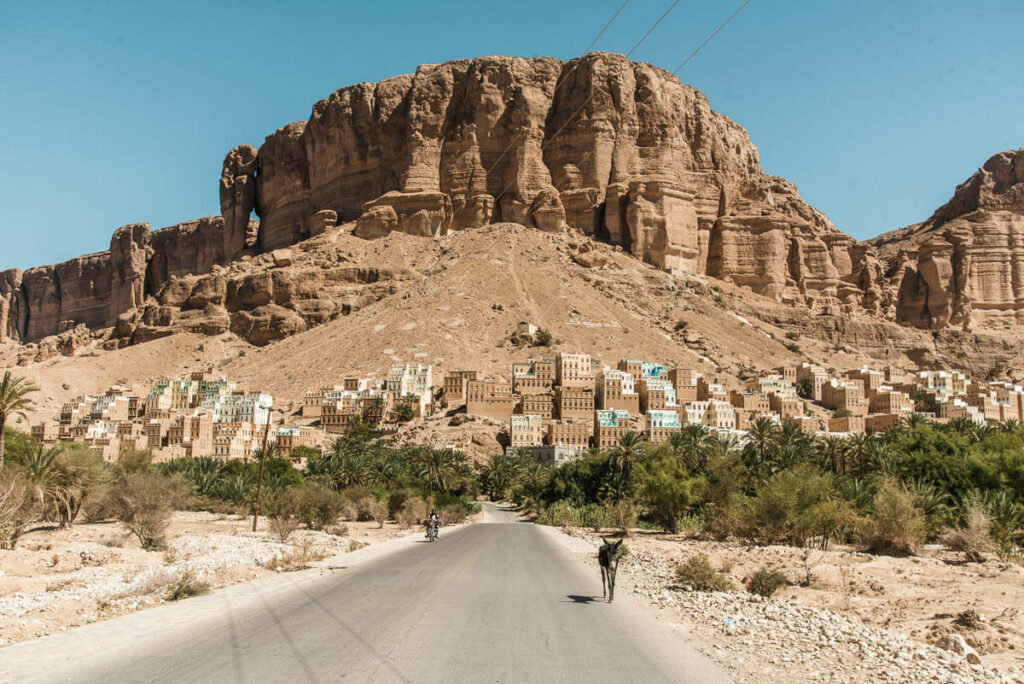
Our road trip around Yemen
The country, people and culture
Yemen is actual Arabia, the place where is believed the Arabs come from, and the birthplace of the Sabaeans, a group of Ancient South Arabians who found Sheba, home to worldwide famous Queen of Shebba, all stories that appear in the Quran and the Hebrew Bible.
In terms of GDP per capita, Yemen is within the 20 poorest countries in the world and along with Afghanistan and North Korea, the only non-African country that makes it to the list.
Despite its location, Yemen is the only country in the peninsula that doesn’t belong to the GCC (Gulf Cooperation Council countries) an agreement between the Gulf States – Bahrain, Kuwait, Oman, Qatar, Saudi Arabia and the United Arab Emirates – similar to the EU.
Culture in Yemen
Yemenis are purely Arabs but from a traveling perspective, sometimes I feel they do have a slight South Asian (Pakistani) twist, in the way they eat and behave, different from the rest of Gulf States.
This shouldn’t be surprising, however, since the coast of Yemen has been benefited from the frankincense trade for centuries, receiving visitors from many parts of the world, specially from South Asia.
Tribal laws in Yemen
They are grouped in tribes and similarly to Pashtuns in Afghanistan, their tribal laws dictate their daily life.
Like Pashtuns, Yemenis treat their guests even better than a family member but at the same time, they are really, really conservative and their acts might be subjected to certain rules that may create absolute rejection to international visitors.
For example, without wanting you to fall in a Yemeni stereotype, a woman having extra marital relations could be one of the most dishonourable things that could happen to a family.
In the city of Seiyun, an unmarried woman was caught in the house hanging out with a stranger man. They weren’t caught having sex, but they were just sitting together. After doing their own research and investigation, the family decided to murder her by cutting their head off.
Such is the strength and importance of their tribal laws that in these cases, the police decides not to intervene.
By the way, this was an extreme case carried out by an uneducated family. Most Yemenis condemned such an act.

A fruit seller in the market of Seiyun

Members of the political Yemeni class
Language
In Yemen, they speak Modern Standard Arabic.
Religion in Yemen
Islam is the state religion, 35% of the population being Shia and 75% Sunni.
Women in Yemen
Yemen is the most conservative country I have ever been to, even more than Afghanistan.
Nonetheless, you need to remember that I only visited the region of Hadramut, a rural and remote area of Yemen, where people are probably more traditional than in the capital Sanaa.
Still, I was particularly shocked by some of the things I experienced.
100% of the women wear niqab
Except for one beggar, we never saw the face of a woman, but all of them were wearing the niqab, which covers everything but the eyes.
You are not allowed to talk to women, not even looking at them
The only female interaction we had was the day we got hissed by a local woman while we were sitting in the car.
All we did was smiling at her, but she reacted with hissing at us.
She basically told you to fuck off – our fixer said.
Saudi women are surprisingly liberal compared to Yemeni
One day, while walking around a village, we heard some young women talking and laughing, something we had not witnessed in that country yet.
They are very liberal – our fixer said. And the reason was that those young girls had been born in Saudi and they came to Yemen to visit their family.
While Saudi women might seem extremely conservative, you are likely to talk with them when you are traveling in Saudi. A Saudi woman with niqab asking for a selfie isn’t rare, plus they work in many supermarkets and shops.
Local women with long hats
When traveling around Yemen, you will notice many local women wearing some pretty high hats. They are farmers and they use those hats to protect themselves from the heat. Apparently, that shape helps to keep her head cooler. Those woman are within the poorest in Yemen and they despise being photographed.

A local farmer sitting next to the road
Yemeni food and cuisine
Yemeni food is heavy and mostly meat and rice-based but I believe they offer the best food in the peninsula.
In fact, Yemeni mandi is one of the most common dishes in Oman, UAE and Saudi.
Yemeni restaurants don’t usually to have tables but people gather on a circle on the floor and eat with their hands from the same plate.
Why is Yemeni honey so famous?
For a long time, Yemen is believed to produce some of the best and purest honey in the world, coming from bees that are exclusive fed from flowers of the Sidr tree, which also has therapeutic properties.
Honey plays a big role in Yemen’s economy and according the the UN, more than 100,000 households depend on it for their livelihoods.
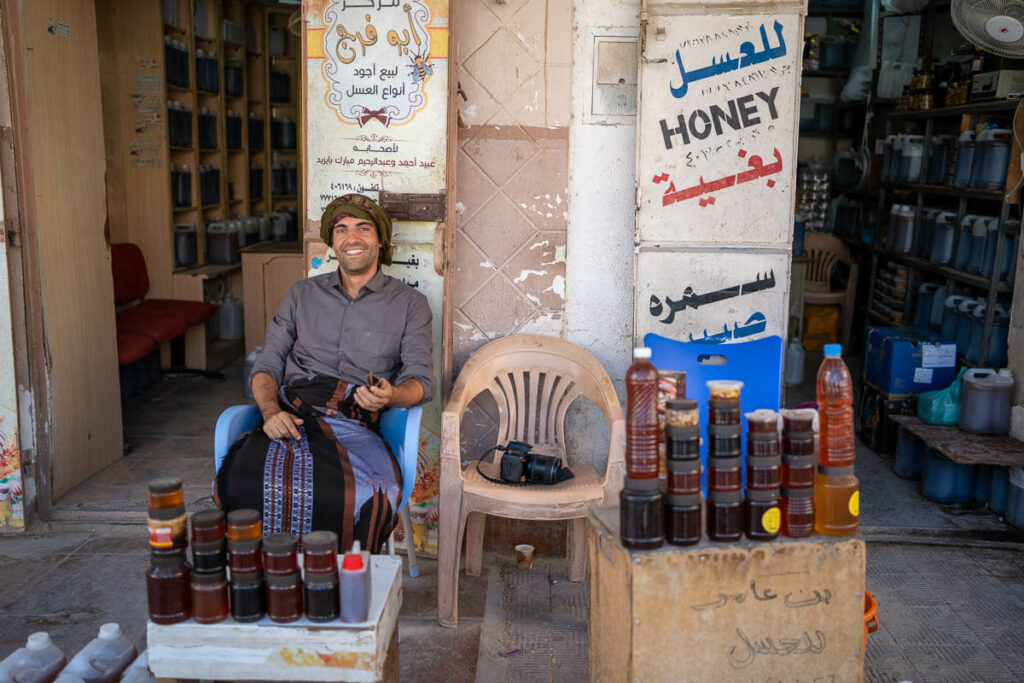
Hanging out in a honey shop
Is there alcohol in Yemen?
Yemen is a dry country, you can’t buy alcohol legally.
How to travel in Yemen as a solo female traveler
Yemen might possibly be the most challenging country in the world to travel as a female traveler, way more difficult than in Afghanistan.
In Afghanistan, foreign women don’t need to wear the burqa, but a hijab is enough, like in Iran.
However, in the region of Hadramut, foreign women must wear the niqab in all public spaces, markets and pretty much everywhere, but in the hotel and in the wild.
You may remove your niqab when you are in the car, but not when going through villages and checkpoints.
Is it safe to travel in Yemen as a female traveler?
As long as you are accompanied by men, traveling in Yemen as a woman is safe.
If you removed your niqab, you’d get a lot of attention but if you are wearing it, nobody will dare to tell you a thing.
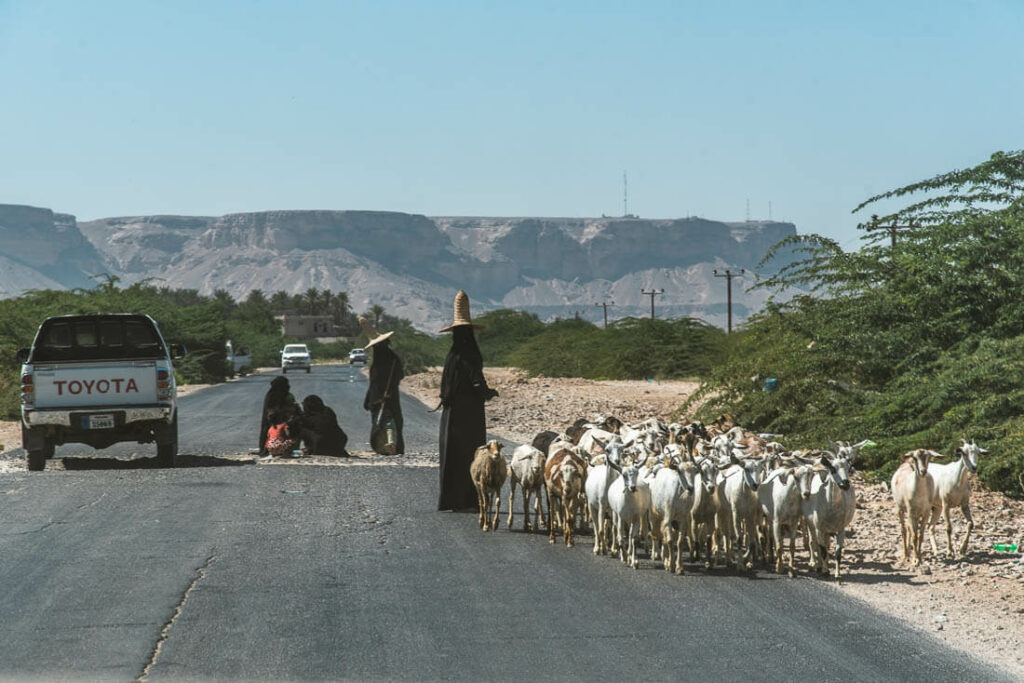
Traffic jam during our road trip around Yemen
Money and prices
In Yemen, they use Yemeni Rials (YRI) and approximately:
$1 = 250 YRI
This is the official currency.
Since recently, in South Yemen, they used a different, unofficial currency also named Yemeni Rials, but with a different value.
With South Yemen Rials,
$1 = around $1000
I never understood why South Yemen adopted a different currency and how was the value defined but in any case, if traveling to Hadramut, that’s the only currency you will see.
TMs and exchanging money
Your debit or credit card will be useless in Yemen, so do bring everything in cash.
The only currency which I recommend to bring is US dollars. They didn’t even want to exchange my Euros, at an acceptable rate at least.
Your US dollars should be brand-new, they are very strict with this.
They actually found a tiny wink stain in one of my bills and they didn’t accept it, even though I received a bunch of dirty Yemeni Rials in exchange.
How much does it cost to travel in Yemen?
A tour to Yemen booked through a local fixer is always all-inclusive, so it’s difficult for me to say what are the actual prices of the most typical things, including hotels and restaurants.
What I can tell you however is that a solo trip to Yemen is expensive, with prices starting at $4500 for a solo 6-day tour, excluding international flights.
If you want to travel to Yemen for cheaper, I recommend joining a group.
Transportation: how to move around Yemen
It will be difficult for me to write this section since I only moved around in a private car, and you are certainly going to do the same.
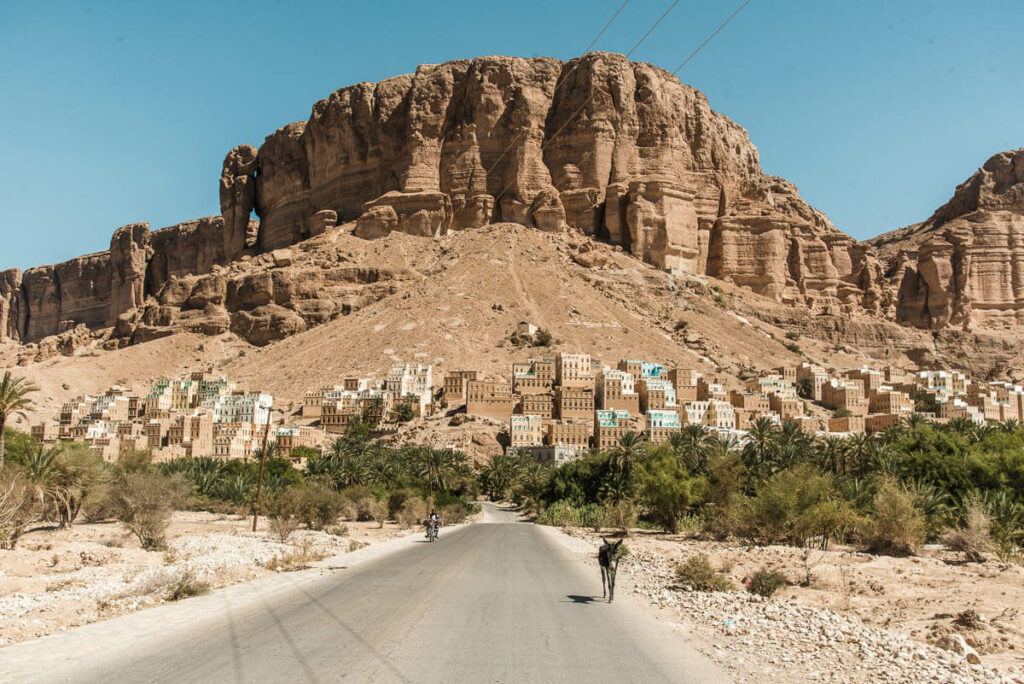
Our road trip around Yemen
Where to stay in Yemen
I stayed in two different hotels:
Hawta Palace Hotel: a traditional boutique hotel in the city of Seiyun. It has a pleasant garden where many local families hang out in the weekends by paying a fee.
Hayd Aljazeel Resort: a mountain resort in Wadi Doa’n with awesome views to the valley.
Both were pretty amazing and I believe the two best options in the area. Other than that, I don’t recall seeing many hotels besides basic ones.
Internet in Yemen
Can you buy a SIM card in Yemen?
You can, but in the region of Hadramut, 4G barely works.
We did have some decent Wi-Fi in the hotel in Seiyun but that’s all what we got during our trip.
Get a VPN for traveling in Yemen
You should always use a VPN when you travel, especially when you connect to public Wi-Fi networks.Your connection will be much safer. Moreover, you will be able to access content which is typically censored in Yemen. I recommend ExpressVPN – Extremely easy to use, fast and cheap. Get ExpressVPNIf you want to learn more about VPN, check: Why you need a VPN for traveling.
More Information
Travel guides to other countries in the Middle East
Iran Travel GuidePalestine Travel GuideSyria Travel GuideTravel Guide to LebanonIraq Travel GuideTravel Guide to Saudi ArabiaTravel Guide to Oman
You will also be interested in: Where in the Middle East is safe? and The most beautiful places in the Middle East.
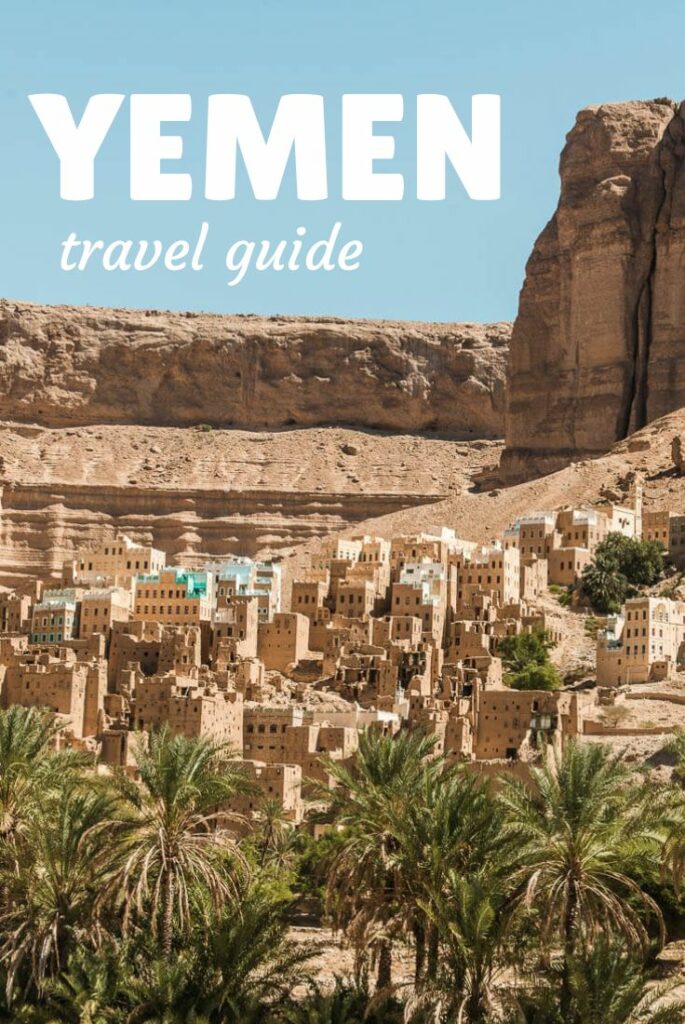
-----------------------------
By: Joan Torres
Title: How to travel to Yemen in 2023
Sourced From: againstthecompass.com/en/yemen-travel/
Published Date: Mon, 20 Mar 2023 15:24:57 +0000
Read More
 Privacy PolicyTerms And Conditions
Privacy PolicyTerms And Conditions
